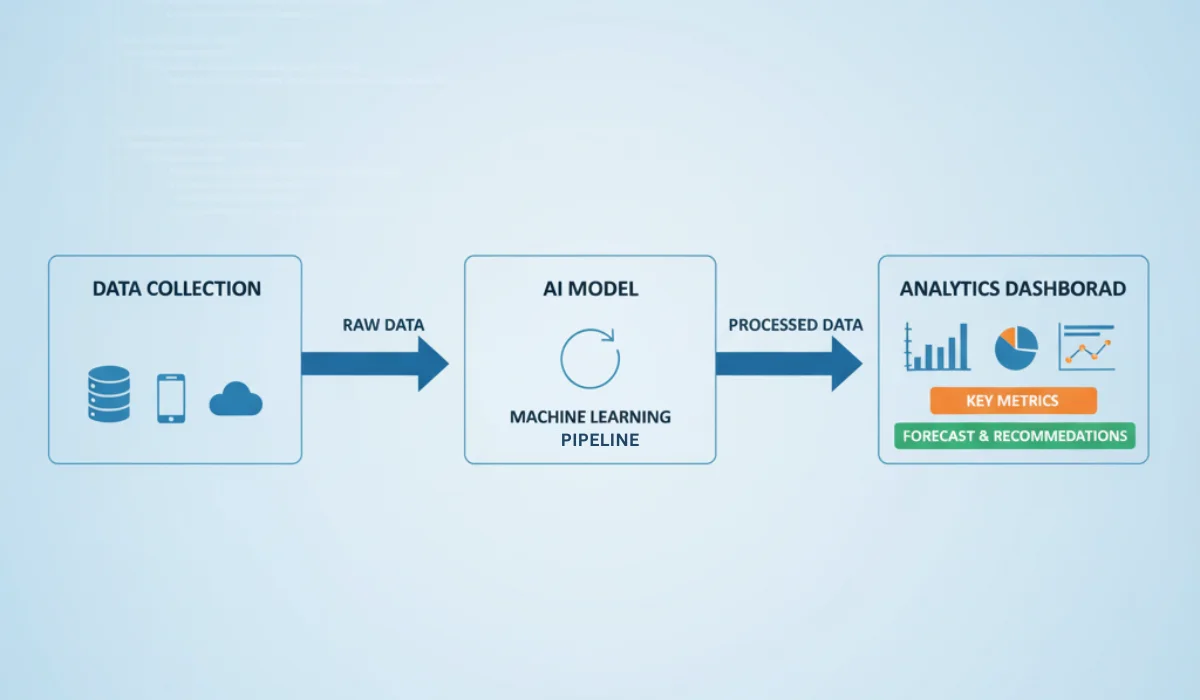Every company today collects more data than it can use. Sales, supply chains, marketing, and operations each produce their own reports and dashboards, but leaders still face the same question: what does it all mean, and how do we act on it fast enough?
That’s where AI-powered data solutions step in. They’re not just analytics tools with new labels. They combine machine learning, automation, and governance to help businesses move from looking backward at data to making forward-looking decisions.
If you’re exploring AI for your organization, the goal isn’t to buy another tool. It’s to understand how AI can turn data into a living system that supports every strategic move, automatically, accurately, and at scale.
What Are AI-Powered Data Solutions?

In simple words, these are digital solutions that use artificial intelligence to analyze complex, scattered, or fast-changing business data. They’re designed to help businesses save time on manual data handling and switch to intelligent automation, where insights are always available on the finger tips, when needed.
Traditional analytics tools rely on people to prepare, sort, and interpret data. AI adds another layer: it learns from patterns and improves over time. These systems can automatically collect data from multiple sources, detect inconsistencies, and suggest corrections ,reducing time spent on manual cleanup.
Here’s what typically falls under the umbrella of data and AI solutions:
- AI for Data Capture: Automates how data is gathered from multiple sources ,documents, emails, IoT sensors, and customer systems. Think of it as an intelligent intake engine. For instance, manufacturers use AI-powered data capture solutions to extract quality readings from machines and flag inconsistencies in real time.
- AI for Data Analytics: Turns all that processed information into predictive insights. Retailers, for example, can forecast demand or optimize inventory by analyzing historical and seasonal data automatically.
- AI-Driven Governance: Keeps data compliant, traceable, and secure. These systems track lineage, maintain audit trails, and ensure decisions made by AI models remain explainable.
When all these elements work together, they create a self-improving data ecosystem, one that learns from outcomes and continuously refines how it delivers insights.
Why Businesses Are Turning to AI for Data Management
Across industries, leaders are realizing that data isn’t the problem ,data complexity is. Over the years, businesses have invested in countless tools for analytics, storage, and visualization. The result? A sprawling network of data sources that rarely talk to each other. Teams operate in silos, reports contradict one another, and strategic decisions get delayed while people reconcile information.
This is where AI-powered data solutions are proving transformative. They go beyond automating reports or dashboards. Instead, they rethink how data flows, learns, and supports decision-making. By applying machine learning and intelligent automation, these systems can clean, connect, and interpret information in real time ,enabling leaders to act on insight, not instinct.
Several shifts are driving this adoption:
- Exploding data volumes. Modern enterprises generate terabytes of operational, customer, and machine data daily. Manual analysis can’t keep up. AI can scan vast datasets to identify correlations or outliers instantly.
- Faster business cycles. Decision windows are shrinking. Quarterly planning isn’t enough when market dynamics can change in a week. AI-driven analytics brings predictive visibility so leaders can respond proactively.
- Efficiency pressures. Maintaining multiple data systems is costly and labor-intensive. AI reduces the need for repetitive tasks like cleansing, tagging, and validation, cutting operational overhead.
- Governance and compliance. Regulations like GDPR or data residency laws require precise control over information. AI in data management helps detect irregularities, track data lineage, and automate compliance workflows.
- Strategic differentiation. Forward-looking organizations use AI for data analytics not just to understand performance, but to anticipate customer needs, forecast demand, and optimize pricing or supply chains before competitors do.
For most leaders, the shift toward data and AI solutions isn’t just a tech upgrade ,it’s a strategic response to complexity. The goal isn’t to collect more data, but to make existing data more intelligent, interconnected, and immediately usable.
Key Benefits of AI-Powered Data Solutions

For business leaders, the promise of AI-powered data solutions lies in their ability to turn fragmented, underutilized data into a living, responsive system that fuels better decisions. The benefits extend beyond automation ,they reshape how the organization understands itself and its market.
Let’s break down the major gains:
1. Smarter, Faster Decision-Making
AI takes traditional analytics a step further by recognizing patterns and predicting outcomes. Instead of waiting for monthly reports, leaders can access insights in real time ,from forecasting inventory needs to predicting customer churn. AI for data analytics transforms decision-making from reactive to anticipatory, letting companies act before trends fully unfold.
2. Automation Across the Data Lifecycle
Data entry, cleansing, classification, and validation have long been manual bottlenecks. AI-powered data capture solutions automate these processes, drastically reducing errors and freeing teams to focus on strategic analysis. Machine learning models continuously improve accuracy, meaning the system gets smarter with every data point it processes.
3. Higher Data Quality and Governance
Reliable decisions depend on clean data. AI algorithms can automatically flag anomalies, detect duplicates, and maintain compliance with evolving regulations. With built-in governance capabilities, AI-powered data solutions help ensure that every decision is traceable, auditable, and based on trustworthy inputs.
4. Real-Time Insight and Operational Agility
In fast-moving markets, timing often defines success. AI for data analysis delivers insights as events unfold ,allowing businesses to adjust pricing, supply chain operations, or marketing efforts instantly. This agility gives enterprises a measurable edge in responding to shifts that slower competitors might miss.
5. Scalability and Cost Efficiency
AI not only automates repetitive tasks but also optimizes infrastructure usage. By identifying inefficiencies in data storage, integration, or computation, it helps cut operational costs. As data grows, AI systems scale seamlessly, ensuring performance doesn’t degrade with size.
6. Innovation Through Accessible Intelligence
Perhaps the most overlooked benefit is democratization. When AI translates complex analytics into plain-language insights, it empowers non-technical teams to engage with data directly. Marketing, HR, or operations managers no longer need to wait for analysts ,they can explore insights themselves and experiment with ideas faster.
In essence, AI isn’t just adding intelligence to data systems ,it’s expanding the organization’s capacity to think, learn, and adapt at scale.
Also Read: Do’s & Don’ts of Using AI for Data Analytics
Common Challenges in Implementing AI Data Solutions
The potential of AI-powered data solutions is undeniable ,but getting there isn’t simple. Many organizations underestimate how much groundwork is required to make AI effective. The technology can automate, predict, and learn, but it’s only as strong as the data and structure that support it.
Here are the most common challenges business leaders face when moving from concept to execution:
1. Data Quality and Accessibility
AI thrives on high-quality, well-organized data. Yet most enterprises struggle with inconsistencies ,duplicate entries, incomplete records, or siloed data locked in legacy systems. If the input is flawed, even the most advanced AI model will deliver unreliable insights. Establishing a unified data architecture and clear ownership becomes essential before implementation.
2. Integration with Legacy Systems
Many businesses operate on decades-old infrastructure. Introducing AI-powered data solutions into this environment can feel like connecting modern software to a moving train. Data pipelines need to be rebuilt, APIs reconfigured, and workflows redesigned. Without a phased plan, integration can become expensive and disruptive.
3. Shortage of Skilled Talent
AI initiatives demand more than just data scientists ,they require cross-functional understanding between business, analytics, and IT. Finding professionals who can translate business goals into data models, and vice versa, remains a persistent bottleneck. Some organizations partner with external data and AI solution providers to bridge this talent gap.
4. Ethical, Privacy, and Compliance Risks
As AI systems gain access to sensitive data, questions around privacy, bias, and governance grow sharper. How are algorithms trained? Are they making fair and explainable decisions? Leaders must ensure their AI for data analysis initiatives align with compliance frameworks like GDPR or HIPAA, and that audit trails exist for every decision made by the model.
5. Measuring ROI and Managing Expectations
Unlike software upgrades, AI transformation rarely delivers instant payback. The value often comes from incremental learning and continuous optimization ,something many boards find hard to quantify early on. Without a clear ROI framework, projects risk being labeled “experiments” instead of strategic investments.
6. Organizational Readiness and Change Management
The hardest part of implementing AI isn’t technical ,it’s cultural. Teams accustomed to manual validation may resist automation. Decision-makers might hesitate to trust machine-generated insights. Building confidence requires transparency, training, and leadership commitment to making AI a long-term capability, not a short-term project.
How to Overcome These Challenges

Implementing AI-powered data solutions successfully requires more than technology investment ,it takes foresight, governance, and an organizational mindset that treats data as a shared asset, not a departmental function. The goal isn’t to eliminate challenges but to build systems that adapt and improve over time.
Here’s how forward-thinking organizations are doing it:
1. Start with a Clear Data Strategy
AI can’t fix a broken data foundation. Before implementation, define what problems you want to solve ,whether it’s faster reporting, improved forecasting, or real-time operational insight. Create a unified data strategy that outlines ownership, data sources, and integration priorities. This gives AI a structured environment to operate effectively.
2. Modernize Your Infrastructure Step by Step
Legacy systems can’t be replaced overnight. Instead, focus on phased integration ,migrating high-impact use cases first, such as AI-powered data capture solutions or automated analytics. Cloud-based data platforms make this transition smoother, offering scalability and flexibility without disrupting ongoing operations.
3. Establish Robust Data Governance
Good governance is the backbone of trustworthy AI. Implement frameworks for data quality checks, lineage tracking, and access control. Use AI for data management to automate compliance monitoring and ensure transparency in how algorithms use and interpret information.
4. Combine Human Expertise with AI Intelligence
AI excels at processing complexity, but it still needs human context. The most successful implementations keep humans in the loop ,analysts validate models, managers refine interpretations, and leaders define how insights are acted upon. This blend of human judgment and machine precision builds confidence and accountability.
5. Upskill and Empower Teams
AI adoption succeeds when people understand how to work with it. Offer training for both technical and non-technical staff ,helping them interpret AI outputs, question assumptions, and make informed decisions. Encourage curiosity instead of compliance; this drives innovation around AI capabilities.
6. Redefine ROI and Success Metrics
Traditional ROI measures don’t always capture the gradual benefits of AI. Beyond financial returns, track improvements in decision speed, data accuracy, and operational efficiency. Early wins ,even small ones ,demonstrate value and sustain executive support for scaling broader data and AI solutions.
7. Partner Strategically, Not Opportunistically
Many organizations lack in-house AI expertise, which makes partnerships essential. Choose an AI development company who doesn’t just deploy solutions but understands your industry’s data landscape, compliance needs, and performance goals. Long-term collaboration ensures your AI system evolves as your business does.
Is AI-Powered Data Worth the Investment?
It’s the question every executive eventually asks ,is AI in data analytics really worth it? The short answer is yes, but not in the simplistic sense of instant ROI or cost savings. The real value of AI-powered data solutions lies in what they unlock over time: agility, visibility, and confidence in every decision the business makes.
1. From Cost Center to Growth Engine
Initially, AI projects may feel like another line item in the IT budget. But once implemented, the impact compounds. Predictive analytics improves demand forecasting, reducing overproduction or stockouts. Automated data capture lowers error rates in operations. Data-driven insights identify new customer opportunities. The result is a system that continuously improves business efficiency and revenue potential.
2. Quantifiable and Intangible Returns
Some gains are easy to measure ,fewer manual hours, reduced reporting cycles, faster decision-making. Others are harder but more significant: improved customer trust through accurate data, better compliance visibility, or the ability to innovate faster than competitors. Over time, these intangible benefits reshape the company’s agility and resilience.
3. Risk Reduction and Informed Decisions
Traditional reporting often tells leaders what has happened. AI for data analysis reveals what’s likely to happen and why ,identifying risks before they escalate. From financial forecasting to customer churn prediction, AI reduces uncertainty and supports evidence-based decisions that align with business strategy.
4. Competitive Differentiation
As AI becomes embedded in data ecosystems, it stops being a tool and becomes a competitive advantage. Early adopters aren’t just collecting data faster ,they’re thinking faster. They can test hypotheses, adjust campaigns, or optimize pricing in hours instead of weeks. That kind of responsiveness compounds market advantage over time.
5. Sustainable Data Strategy
An often-overlooked return is the foundation AI builds for the future. By automating governance, integration, and analytics, businesses lay the groundwork for advanced capabilities like generative AI and autonomous decision-making. Data and AI solutions create not just short-term gains but a structure that supports innovation for years.
So, is AI worth it? Only if it’s treated as a strategic investment, not a one-time project. The organizations that see lasting returns are those that align AI with business outcomes, embed it into operations, and allow it to evolve alongside the enterprise.
Conclusion
AI isn’t replacing how organizations work with data ,it’s redefining it. The move toward AI-powered data solutions marks a shift from static reporting to continuous, intelligent insight. But success doesn’t come from technology alone. It comes from aligning AI with clear business goals, preparing the data foundation, and cultivating teams that trust and understand what AI reveals.
For most leaders, the real transformation isn’t technical ,it’s cultural. The organizations winning with AI for data analytics are the ones treating data as a living system that learns, adapts, and grows with the business.
The takeaway is simple: AI won’t fix broken processes, but it will magnify what’s already strong. Build clarity first, intelligence second ,and you’ll find that the right data and AI solutions don’t just support decisions; they sharpen them.






